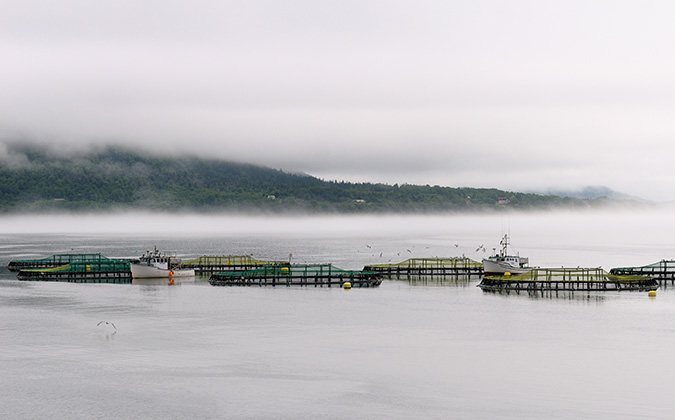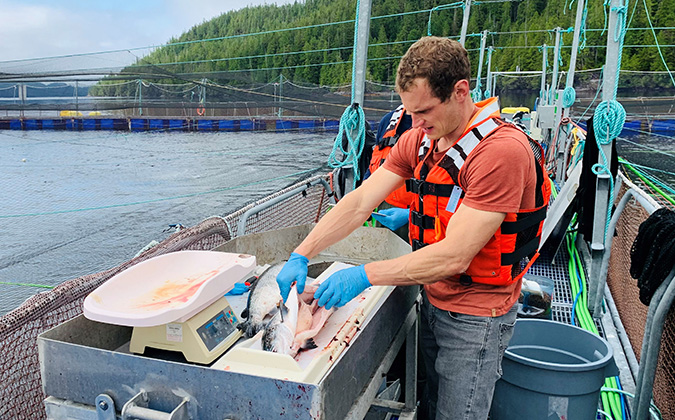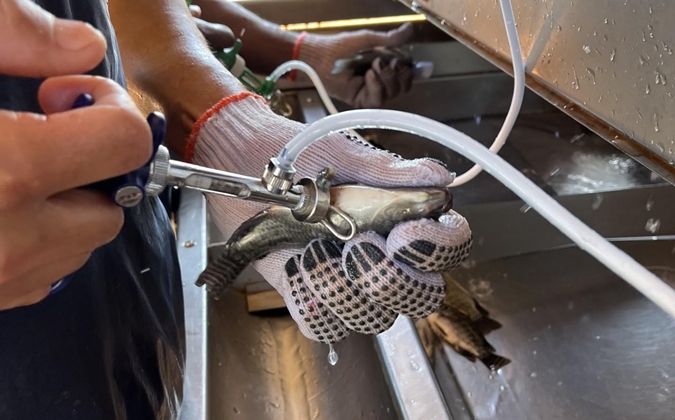
Fish Farm Forum is pleased to host this editorial page on behalf of Pharmaq.
Pharmaq
Ensuring elite disease management during challenging time for Canada’s salmon farms
Salmon farming in Canada is facing some unprecedented challenges, but there is no sign of the industry letting its guard down when it comes to disease prevention.
Political issues currently hang over the sector, with concerns about the effects of aquaculture on wild Fraser River sockeye salmon driving moves to phase out aquaculture off the coast of British Columbia (BC). This is despite a multi-phase study from the Canadian Science Advisory Secretariat (CSAS) showing “minimal risk” to wild salmon from pathogens associated with farmed fish in the region.
Meanwhile, a broader political promise to end net-pen salmon farming across Canada, in favor of onshore and semi-closed pen settings, adds further uncertainty.
“We have a tremendous number of wild salmon in BC. I think it’s roughly 100 wild salmon for every farmed salmon, and if you compare that to Norway, it’s pretty much the opposite. Wild salmon is incredibly important to Canada as a nation,” Michael Ness, aquaculture technical support and account manager for PHARMAQ, explained.
“There’s so much attention focused on this interaction between wild and farmed fish, and while it is human nature to want a ‘smoking gun,’ the picture is a lot more complex. Climate change, reduced availability of food sources and habitat destruction are all likely to have a great impact on the life cycles of wild fish, especially when the fish are small and vulnerable.”
Disease prevention top of minds
The results of the CSAS investigations only serve to highlight the “world class” biosecurity and health protocols in the country’s salmon aquaculture, he noted.
“Producers know that the better their biosecurity is, the more it will protect them as well. There’s clear incentive for them to have extremely high biosecurity protocols,” he said.
Cooperation is also crucial, with a memorandum of understanding ensuring that companies in BC keep each other informed of any emerging pathogens. The companies also coordinate protective measures such as sea lice treatments, to ensure maximal efficacy across the board.
Successful vaccination is an essential part of minimizing disease outbreaks and helping to ensure the lowest possible pathogen spillover into the neighboring environment.
“We have effective vaccines for around 75% of the pathogens that were looked at in the CSAS review, so that’s very strong protection in the sea, limiting the amount of disease on the farms,” Ness continued.
“Even with information available to the public, I don’t think a lot of people understand just how effective the vaccines are, especially against some of the major pathogens like furunculosis and vibriosis. They’re not even issues anymore, whereas in the ‘80s and ‘90s, they were devastating.”
New vaccines add to industry toolbox
In a busy year, PHARMAQ is launching three vaccine products for the Canadian market: ALPHA ERM Salar, ALPHA JECT micro® 7 ISA and ALPHA JECT micro® 5. The products provide immunity against a range of economically significant salmon pathogens, with ALPHA JECT micro 7 ISA conditionally licensed specifically for use against pathogens found on the East Coast.
While ALPHA ERM Salar and ALPHA JECT micro 7 ISA have previously been licensed in other salmon-producing markets, they were only available for use by Canadian veterinarians through application for a special permit. Licensing in Canada will now enable local storage and faster turnaround when needed. ALPHA JECT micro 5, however, is an entirely new formulation specifically developed for the Canadian aquaculture industry based on a strong commercial request for a licensed winter ulcer vaccine
Safety and efficacy of ALPHA ERM Salar and ALPHA JECT micro 7 have already been proven through permitted use in Canada and, more extensively, in Norway.
Field trials using all three products in a commercial setting have ensured they meet safety requirements for licensing of veterinary biologics in Canada. Beyond that, a major part of the service PHARMAQ provides is to follow fish throughout the vaccination process, to ensure proper administration and, ultimately, a strong immune response in fish populations.
The arrival of the new vaccines in the Canadian market helps to address a limited availability of fully licensed fish-health products available to the nation’s farmers and underlines Zoetis’ commitment to these markets, Ness explained.
“We’re trying to have a comprehensive portfolio of products to be used by farmers, to keep production sustainable and healthy and keep things growing. We know that there’s no way forward in BC, and likely eastern Canada as well, without strong, sustainable practices.”
Winter ulcer vaccine component a winner
Grieg Seafood is one BC producer making disease prevention a major priority in the face of regional pathogen threats.
The company uses two hatcheries. One is a flow-through system, where there have been some issues with Yersinia ruckeri, which causes enteric redmouth disease, but bath vaccination using ALPHA ERM Salar has kept the pathogen well under control, Patrick Whittaker, DVM, head veterinarian for the company, said.
The other is the company’s own facility, which is largely a recirculating aquaculture system but is flow-through for first feeding. There, incursions of surface water into the wells that the company sources water from have sometimes introduced Aeromonas salmonicida, and there have been periodic outbreaks of Y. ruckeri.
“Vaccination has been a big part of our strategy, but water disinfection and biosecurity has probably been the primary focus. The idea being, hopefully, to both keep them out and then have the immunity there so that if a break in our biosecurity does occur, we don’t have clinical disease,” Whittaker explained.
Vaccination protocols have changed since he started working at Grieg in 2016. Since then, every fish has been vaccinated with a product which has a Moritella viscosa component, the pathogen that causes winter ulcers, which can result in severe welfare issues. There is also a product quality aspect, he noted, since previously, the company had seen significant downgrades in some regions due to the presence of winter ulcers.
“We’d done some trial work using ALPHA JECT 5-3 (Norwegian-licensed M. viscosa vaccine) on a special permit and seen a real significant reduction in ulcers, and so then as PHARMAQ has moved to the micro dose, we’re very happy with that, because it answers two of our issues in terms of vaccination marks and vaccination downgrades, but still contains the M. viscosa component. 100% of my fish are vaccinated with the ALPHA JECT micro 5,” he continued.
“Mortality has remained very low, which is reassuring for me because that’s the one I worry about. The quality people worry about the downgrades, and this works for them because there are fewer ulcers, but my main concern is that fish are protected from disease.”
Regulatory approval in Canada can be challenging for some classes of products, Whittaker conceded, pointing to sea lice-control products that have utility worldwide but are yet to be cleared for use in Canada.
Tenacibaculum remains the biggest problem in terms of mortality on the West Coast. He hopes to see a vaccine available in the near future but acknowledges that while the challenge remains specific to BC, it is unlikely to be top priority for research and development investment.
Changes to production methods ahead
A shift toward semi-closed or land-based salmon-production systems in the coming years will inevitably require significant investment. Here, Ness explained, well-executed vaccination programs help to deliver the predictability that investors are likely to be looking for.
“I think that’s one pretty strong argument for continuing with good vaccination programs and good vaccines. It just brings a more predictable nature to production. Ultimately, an investor wouldn’t want to invest in a company that loses 50% of its stock every few years,” he said.
In addition to negating the risk of sea lice, land-based systems should offer more control over factors such as water quality, he continued, but they are not invulnerable to pathogens, and their closed nature means that should a disease-causing agent get in, they can reproduce rapidly and easily infect fish.
“It just takes one cycle where a pathogen gets in, and suddenly, you’ve potentially lost a lot of fish. It doesn’t take a lot to scare investors away, so taking preventative measures and demonstrating a strong track record will be very important for these facilities,” he added.
Posted on: April 23, 2024








